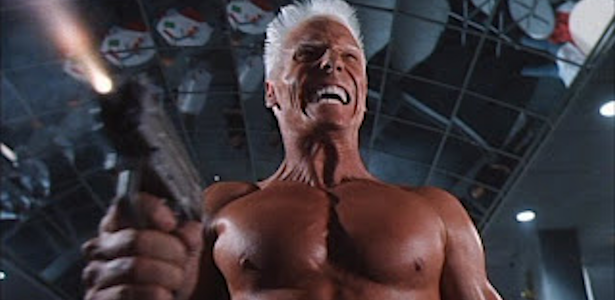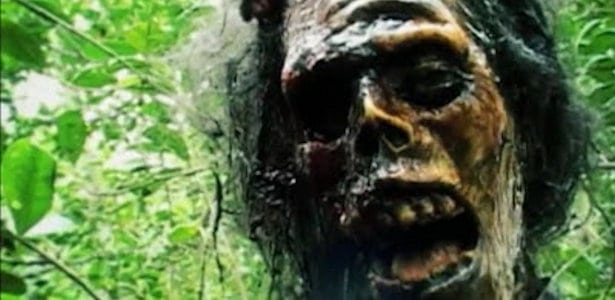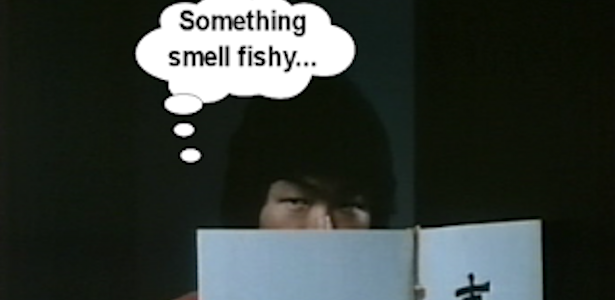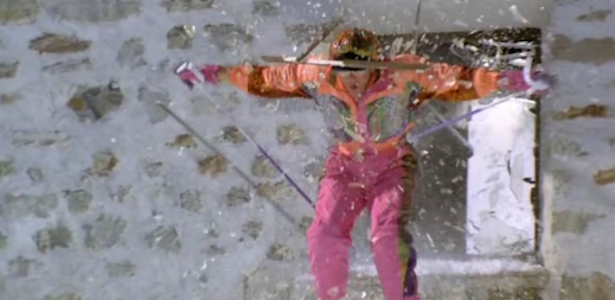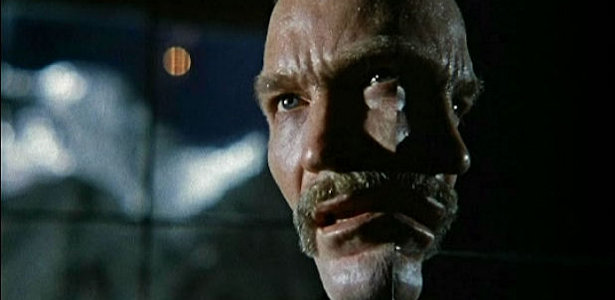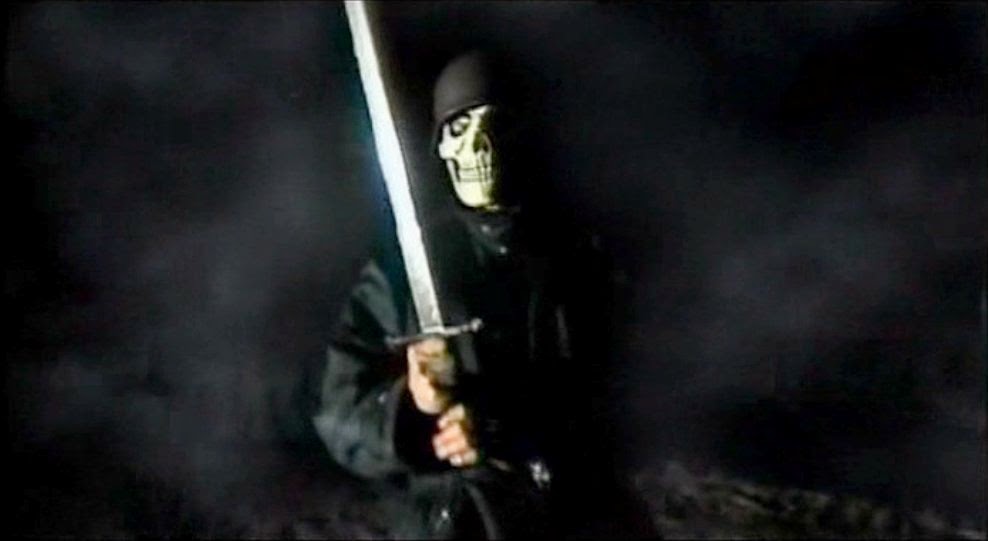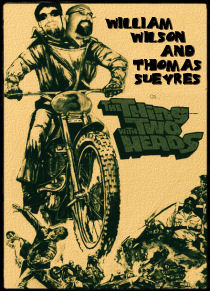Let’s get the bad pun out of the way right off the bat. I have the foggiest memory of this film back in 2000 or so. Some horror news site had a tiny blurb about the Germans making THE FOG 2 and Andreas Schnaas was someone involved. My brain somehow concocted this image of a gory-as-hell flick with cool looking rotting sailor zombies; something along the lines of the cheap-but-entertaining ANTHROPOPHAGUS 2000 (1999). My brain is messed up. This was before I knew the depths of how bad German shot-on-video cinema could be. And it was before I knew the name Oliver Krekel. Shot in 1999 but not released (unleashed?) upon the public for several years, THE FOG 2 (technically the title is FOG², which makes no sense) is nothing more than a glorified home movie that will make you question the stereotype of Germans being efficient with solid craftsmanship.
The film opens with six Nazi soldiers being executed on a beach and their bodies being left to the sea. We assume this was in the past since it was in black and white. Director Krekel then cuts to shots of the ocean with a quote about fog credited to one C. Newport. Once again, the viewer is left to assume. This could be English seaman Christopher Newport (and I only know about him because Christopher Newport University is just down the road from me) or it could be Chet “Slim” Newport, black sheep of the Newport cigarette empire. That will give you a hint of how Krekel doesn’t give a damn. We then jump right into a dream sequence as Jenny (Nadine Nigge, soon to be Krekel’s wife) is haunted by six guys shown in negative image who bellow stuff like, “Du hast uns getötet” (“You killed us”) while pointing swords at her. She wakes up from her nightmare to find she is safe and sound inside a car.
Her companions are driver Philipp (Krekel), Lukas (Martin Brunnett), Lisa (Katja Clobes) and Tom (Wolfram Saathoff). Damn, you just know the guy named Tom is going to be the troublemaker. It appears this motley mannschaft is heading to the beach in Klitmoller, Denmark for a vacation. The group stops for a bathroom break and we learn that Tom is a prankster as he scares Lisa while wearing a Jason-style hockey mask. Knew that guy named Tom would be trouble. Anyway, they arrive in town and find the village empty. They bang on a couple of doors to see if anyone has a house for rent (apparently pre-planning a vacation is a no-no), but eventually get a place for a guy I’ll just call random dude (Haiko Herden). The five friends decide to head down to the beach and check out the bunkers left over from World War II. Bad news as the second they are down there another random dude runs out screaming about money before taking out a gun and shooting himself in the head. Philipp and Tom run to find an authority to inform and we get first random dude’s brother who I will call randomer dude (Olaf Clobes). He tells them to go back to the house and not worry about it.
Back at the rental house, Jenny argues that they should leave because Lisa is in shock and nothing spoils a vacation like a random suicide. They decide to stay the night, which allows for another dream sequence for Jenny. The next morning Philipp and Tom head off to return the keys while we get a riveting scene of luggage loading. Their plans to split are foiled though because random dude has left a note on his door that he has gone night fishing (never mind that it is still daylight). The group decides the best course of action is to go back to the beach to find him so they can drop off the keys and pay this dude. Yes, much more logical than leaving him a note and envelope at his home. Once again, the beach proves to be a place of death as they find him with his throat torn out. They get randomer dude on the scene and he declares it was selbstmord (suicide). Two days, two dead bodies on the beach. Worst…vacation…ever.
Naturally, these guys think something is up and decide to search random dude’s house with the set of keys Philipp boosted off his corpse. This leads to a riveting house searching scene. Watch Lukas open a cabinet and then another cabinet and then another cabinet. The lone item from this haul is a key that opens the indoor fireplace. Inside they find a book. This book must be important as random dude returns from the dead with his brother’s severed head. The group splits but not before Philipp gets stabbed to death and random dude gets a pick-axe in the gut and his hand lopped off. The four remaining folks make it to another house and decide the best course of action isn’t to try to call for help. Nope, they need to read this book. It is apparently a diary from 1942 and details the preparation of six German officers as they concocted a plan to assassinate Hitler. Hmmm, I bet one of them is named Tom. Anyway, the diary also contains a newspaper clipping that says “Attentat Erfolgreich Verhindert: Verrater Executiert” (Assassination Successfully Prevented: Traitors Executed). Also included is a piece of paper about the killings and Jenny freaks out when she sees the signature of the person who signed off on them. Turns out it was Erich Hansen, her grandfather. For some reason Lukas and Lisa head to the town’s lighthouse and the keeper (a slumming Andreas Schnaas; yes, slumming) tells them more info about how the town’s mayor hid some money in the bunker and the dead guys want it back. Life in the afterlife ain’t cheap. Finally, around the 43 minute mark, the fog rolls in and it is a race to find the geld and appease these pissed off spirits.
fireplace. Inside they find a book. This book must be important as random dude returns from the dead with his brother’s severed head. The group splits but not before Philipp gets stabbed to death and random dude gets a pick-axe in the gut and his hand lopped off. The four remaining folks make it to another house and decide the best course of action isn’t to try to call for help. Nope, they need to read this book. It is apparently a diary from 1942 and details the preparation of six German officers as they concocted a plan to assassinate Hitler. Hmmm, I bet one of them is named Tom. Anyway, the diary also contains a newspaper clipping that says “Attentat Erfolgreich Verhindert: Verrater Executiert” (Assassination Successfully Prevented: Traitors Executed). Also included is a piece of paper about the killings and Jenny freaks out when she sees the signature of the person who signed off on them. Turns out it was Erich Hansen, her grandfather. For some reason Lukas and Lisa head to the town’s lighthouse and the keeper (a slumming Andreas Schnaas; yes, slumming) tells them more info about how the town’s mayor hid some money in the bunker and the dead guys want it back. Life in the afterlife ain’t cheap. Finally, around the 43 minute mark, the fog rolls in and it is a race to find the geld and appease these pissed off spirits.
Gott im Himmel! If you are wondering why I keep saying in my review that someone named Tom might be trouble it is because it’s true. I was living a quiet and peaceful existence until two weeks ago when VJ co-blogger Tom sent me an email that said “you should totally review this.” Inside was a link to THE FOG 2. Knowing my weaknesses too well, I soon found myself with a copy (courtesy of Tom, that sly bastard!). That combined with no life creates a scary situation. It is as if Tom wanted me to suffer the same pain he endured during Krekel’s later ROBIN HOOD: GHOSTS OF SHERWOOD (2012). A multi-hyphenate of the lowest order Krekel did almost everything on this film from the driving to the editing to the computer FX to the directing. I’m sure it is him hiding behind the Mr. Magoo credit for the music (really!). So when it comes to laying the blame at anyone’s feet, we can only blame Tom…er, I mean, Krekel!
Krekel has maintained this was only a fun exercise in filmmaking with friends not to be seen by the public. That would hold water…had he not released it publicly via his Astro label. Hiding behind a “for the fans by the fans” shield, Herr Director hasn’t so much created a film as he has a glorified home movie. Now I’m not expecting mind blowing camera work or state-of-the-art effects. My anticipation is nil when it comes to shot-on-video flicks, but this fails even my realistically low expectations. Hell, we can’t even get proper lighting in this thing (see pic to the right). Truth be told, I’ve shot better home movies. The only difference is I didn’t release them to the public to try and make money. And this is not to say that Krekel didn’t have ample opportunity to make something worthwhile. For example, the town of Klitmoller is a very cool looking place and the idea of it deserted is appropriately atmospheric. But he can’t capitalize. Same goes for the abandoned bunkers on the beach. That is free production value, but he can’t bother to exploit it properly.
Let us not forget the shameful exploitation of John Carpenter and his 1980 horror classic. As if having unimaginative Hollywood hellbent on remaking his entire filmography weren’t bad enough, now he has to contend with leeches with video cameras (honestly, the porn versions of HALLOWEEN had more substance and style). It is doubly painful when you realize this all had potential if it had a budget and competent filmmakers. The concept of Nazi zombies haunting the waves is some that has been proven popular both before (SHOCKWAVES) and after (the unmade WORST CASE SCENARIO) this film. But here is it D.O.A. as our baddies are guys literally wearing the cheapest skull masks you can imagine (you can clearly see their non-rotting human necks where the masks end) while sporting perfectly fine human hands. It was too much hassle to find gloves? No, apparently not as some scenes have them wearing gloves. That is just lazy. Even the gore department, where Germans usually thrive, is poorly done. This simplicity is matched by the script, which was so basic that I could even follow it with my German being rustier than a undetonated WWII bomb stuck in the dirt. Is there anything positive I can say about the film? The good news? It only runs 60 minutes. The bad news? It exists.
The film opens with six Nazi soldiers being executed on a beach and their bodies being left to the sea. We assume this was in the past since it was in black and white. Director Krekel then cuts to shots of the ocean with a quote about fog credited to one C. Newport. Once again, the viewer is left to assume. This could be English seaman Christopher Newport (and I only know about him because Christopher Newport University is just down the road from me) or it could be Chet “Slim” Newport, black sheep of the Newport cigarette empire. That will give you a hint of how Krekel doesn’t give a damn. We then jump right into a dream sequence as Jenny (Nadine Nigge, soon to be Krekel’s wife) is haunted by six guys shown in negative image who bellow stuff like, “Du hast uns getötet” (“You killed us”) while pointing swords at her. She wakes up from her nightmare to find she is safe and sound inside a car.
Her companions are driver Philipp (Krekel), Lukas (Martin Brunnett), Lisa (Katja Clobes) and Tom (Wolfram Saathoff). Damn, you just know the guy named Tom is going to be the troublemaker. It appears this motley mannschaft is heading to the beach in Klitmoller, Denmark for a vacation. The group stops for a bathroom break and we learn that Tom is a prankster as he scares Lisa while wearing a Jason-style hockey mask. Knew that guy named Tom would be trouble. Anyway, they arrive in town and find the village empty. They bang on a couple of doors to see if anyone has a house for rent (apparently pre-planning a vacation is a no-no), but eventually get a place for a guy I’ll just call random dude (Haiko Herden). The five friends decide to head down to the beach and check out the bunkers left over from World War II. Bad news as the second they are down there another random dude runs out screaming about money before taking out a gun and shooting himself in the head. Philipp and Tom run to find an authority to inform and we get first random dude’s brother who I will call randomer dude (Olaf Clobes). He tells them to go back to the house and not worry about it.
Back at the rental house, Jenny argues that they should leave because Lisa is in shock and nothing spoils a vacation like a random suicide. They decide to stay the night, which allows for another dream sequence for Jenny. The next morning Philipp and Tom head off to return the keys while we get a riveting scene of luggage loading. Their plans to split are foiled though because random dude has left a note on his door that he has gone night fishing (never mind that it is still daylight). The group decides the best course of action is to go back to the beach to find him so they can drop off the keys and pay this dude. Yes, much more logical than leaving him a note and envelope at his home. Once again, the beach proves to be a place of death as they find him with his throat torn out. They get randomer dude on the scene and he declares it was selbstmord (suicide). Two days, two dead bodies on the beach. Worst…vacation…ever.
Naturally, these guys think something is up and decide to search random dude’s house with the set of keys Philipp boosted off his corpse. This leads to a riveting house searching scene. Watch Lukas open a cabinet and then another cabinet and then another cabinet. The lone item from this haul is a key that opens the indoor
 fireplace. Inside they find a book. This book must be important as random dude returns from the dead with his brother’s severed head. The group splits but not before Philipp gets stabbed to death and random dude gets a pick-axe in the gut and his hand lopped off. The four remaining folks make it to another house and decide the best course of action isn’t to try to call for help. Nope, they need to read this book. It is apparently a diary from 1942 and details the preparation of six German officers as they concocted a plan to assassinate Hitler. Hmmm, I bet one of them is named Tom. Anyway, the diary also contains a newspaper clipping that says “Attentat Erfolgreich Verhindert: Verrater Executiert” (Assassination Successfully Prevented: Traitors Executed). Also included is a piece of paper about the killings and Jenny freaks out when she sees the signature of the person who signed off on them. Turns out it was Erich Hansen, her grandfather. For some reason Lukas and Lisa head to the town’s lighthouse and the keeper (a slumming Andreas Schnaas; yes, slumming) tells them more info about how the town’s mayor hid some money in the bunker and the dead guys want it back. Life in the afterlife ain’t cheap. Finally, around the 43 minute mark, the fog rolls in and it is a race to find the geld and appease these pissed off spirits.
fireplace. Inside they find a book. This book must be important as random dude returns from the dead with his brother’s severed head. The group splits but not before Philipp gets stabbed to death and random dude gets a pick-axe in the gut and his hand lopped off. The four remaining folks make it to another house and decide the best course of action isn’t to try to call for help. Nope, they need to read this book. It is apparently a diary from 1942 and details the preparation of six German officers as they concocted a plan to assassinate Hitler. Hmmm, I bet one of them is named Tom. Anyway, the diary also contains a newspaper clipping that says “Attentat Erfolgreich Verhindert: Verrater Executiert” (Assassination Successfully Prevented: Traitors Executed). Also included is a piece of paper about the killings and Jenny freaks out when she sees the signature of the person who signed off on them. Turns out it was Erich Hansen, her grandfather. For some reason Lukas and Lisa head to the town’s lighthouse and the keeper (a slumming Andreas Schnaas; yes, slumming) tells them more info about how the town’s mayor hid some money in the bunker and the dead guys want it back. Life in the afterlife ain’t cheap. Finally, around the 43 minute mark, the fog rolls in and it is a race to find the geld and appease these pissed off spirits.Krekel has maintained this was only a fun exercise in filmmaking with friends not to be seen by the public. That would hold water…had he not released it publicly via his Astro label. Hiding behind a “for the fans by the fans” shield, Herr Director hasn’t so much created a film as he has a glorified home movie. Now I’m not expecting mind blowing camera work or state-of-the-art effects. My anticipation is nil when it comes to shot-on-video flicks, but this fails even my realistically low expectations. Hell, we can’t even get proper lighting in this thing (see pic to the right). Truth be told, I’ve shot better home movies. The only difference is I didn’t release them to the public to try and make money. And this is not to say that Krekel didn’t have ample opportunity to make something worthwhile. For example, the town of Klitmoller is a very cool looking place and the idea of it deserted is appropriately atmospheric. But he can’t capitalize. Same goes for the abandoned bunkers on the beach. That is free production value, but he can’t bother to exploit it properly.
Let us not forget the shameful exploitation of John Carpenter and his 1980 horror classic. As if having unimaginative Hollywood hellbent on remaking his entire filmography weren’t bad enough, now he has to contend with leeches with video cameras (honestly, the porn versions of HALLOWEEN had more substance and style). It is doubly painful when you realize this all had potential if it had a budget and competent filmmakers. The concept of Nazi zombies haunting the waves is some that has been proven popular both before (SHOCKWAVES) and after (the unmade WORST CASE SCENARIO) this film. But here is it D.O.A. as our baddies are guys literally wearing the cheapest skull masks you can imagine (you can clearly see their non-rotting human necks where the masks end) while sporting perfectly fine human hands. It was too much hassle to find gloves? No, apparently not as some scenes have them wearing gloves. That is just lazy. Even the gore department, where Germans usually thrive, is poorly done. This simplicity is matched by the script, which was so basic that I could even follow it with my German being rustier than a undetonated WWII bomb stuck in the dirt. Is there anything positive I can say about the film? The good news? It only runs 60 minutes. The bad news? It exists.




